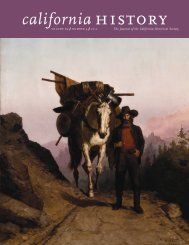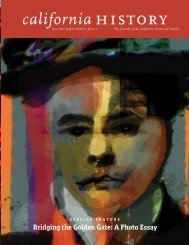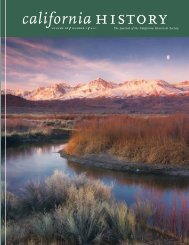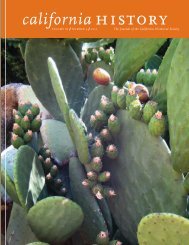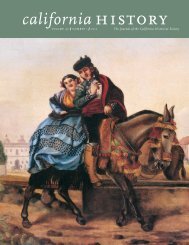The attraction, however, was fleeting. Strollingalong Fulton Street in the south campus area,Delacour passed the two-story frame house thatserved as headquarters for the Vietnam DayCommittee (VDC), noticed “a pretty girl in thewindow,” and eagerly volunteered. His fervor forthe cause was quickly doused by the assignmentof “shit work,” such as setting up microphonesfor speeches to be made by VDC leaders and slavingover mailing lists. Later, in 1968, he workedzealously in the Peace and Freedom Party’s registrationdrive. In October of that year, GovernorRonald Reagan and the UC Board of Regents prohibitedthe Peace and Freedom Party presidentialcandidate and Black Panther leader, EldridgeCleaver, from presenting a series of guest lectureson campus. Delacour was arrested duringthe ensuing campus protest on charges of disturbingthe peace, malicious mischief, and trespassfor his role in the seizure of Moses Hall. Heserved a ten-day jail sentence and, by the end ofthe election, was once again profoundly distrustfulof the radicals’ schismatic, internally dividedpolitics: “We suddenly had gained some power,but then we started dividing the spoils—formingorganizations and bureaucracies—and everyonebecame ego-involved in endless hassles.” 11The idea of building a park upon the university’svacant lot occurred to Delacour while organizinga community rock concert: “I contacted this bandcalled the Joy of Cooking to see if they’d play andthey said ‘Yeah.’ So we went up and looked atthe lot. The property was a mess—lots of brokenglass, mud holes, and abandoned cars. It wastoo ugly, so we called off the concert. We neededa park there.” He called for an organizationalmeeting at his dress shop, and the first gatheringof the park’s developers was held on Tuesday,April 15, 1969. It attracted five volunteers: WendySchlesinger, John Angelo, Paul Glusman, StewAlbert, and a carpenter named Curtis. 12Schlesinger, a stunningly beautiful blonde andthe only female among those credited with conceptualizingthe park, became the project’s primaryfundraiser, collecting nearly $2,000 fromlocal merchants, churches, and residents. Shehad graduated from college at the age of nineteen,taught English for six months in Long Island,New York, and then headed for Berkeley withthe ostensible—but easily diverted—intention ofattending graduate school. In a New York TimesMagazine article, Winthrop Griffith describedher as “both feminine and forceful . . . a girl whospeaks with a vocabulary almost equally devotedto four-letter words and such gentle concepts as‘love . . . freedom . . . justice . . . beauty.’” 13As a member of the People’s Park Committee, WendySchlesinger (second from left) negotiated continuouslyon behalf of park advocates. She was one ofeleven committee members who met on May 14 inhopes of reaching a last-minute settlement on the fateof the park. People’s Park, she contends, “marked thebeginning of the modern-day communitarian ecologymovement.”Photographer unknown1<strong>California</strong> History • volume 88 number 1 2010
Little is known about Curtis except his occupation.John Angelo was an eager nineteen yearold who volunteered to commute each week toVallejo to pick up grass sod. Paul Glusman wasinfamous among Berkeley radicals for his “senseof the absurd,” best manifested by his ownorganization of one, the Concerned Stalinistsfor Peace. He was also notorious to the Berkeleypolice for his role in organizing the Moses Hallsit-in and was one of three activists charged,though never convicted, with criminal conspiracyin connection with the building’s seizure. 14Stew Albert, another well-known Berkeley politico,was a native of Brooklyn, where he attendedPace University, earning a bachelor’s degree withan emphasis in politics and philosophy. Aftermoving to Berkeley in 1965, he was one of thefour principal founders of the Free University ofBerkeley (FUB), which offered innovative coursesdeemed unacceptable to mainstream academicthought. A close confidant of Yippie founder andleader Jerry Rubin, he mirrored Rubin’s quirkypassage from the somber Maoism of the ProgressiveLabor (PL) Party to the “do your own thing,”culturally-oriented yet politically-involved Yippiesprotest. Rubin described Albert as “the wildestteacher at the University of <strong>California</strong>,” who wascapable of attracting massive crowds to lectures“about pot, Vietnam, God, the university, sex, andCommunism.” 15In the spring of 1967, Albert served as Rubin’scampaign manager for his Berkeley mayoral bidand the next year plunged into organizing theYippies’ “Festival of Life” at the 1968 DemocraticParty convention in Chicago. He was arrestedduring the altercations with Chicago police andfor participating in the Moses Hall sit-in uponreturning to Berkeley in the fall. Todd Gitlin,president of Students for a Democratic <strong>Society</strong>(SDS) from 1963 to 1964 and now a sociologyprofessor at Columbia University, depicted Albertas “a bohemian ex-PLer with curly blond locksand a guileless manner who had turned RubinActivist Stew Albert wrote the April 18, 1969, call to action in the BerkeleyBarb to build a community park, urging people to “bring shovels, hoses,chains, grass, paints, flowers, trees, bull dozers, top soil, colorful smiles,laughter and lots of sweat.” In his 1970 run for Alameda County Sheriff,he carried the city of Berkeley with 65,000 votes.Photo: © Robert Altman, www.altmanphoto.comon to marijuana and for years enjoyed flirtingwith the idea of a hip-radical fusion.” 16The nucleus of six park developers soon expandedto include Jon Read, Mike Lyon, Art Goldberg,Frank Bardacke, William Crosby “Big Bill” Miller,and “Super Joel” (Joseph Eric) Tornabene. Readwas a professional landscape architect who hadgraduated from UC Berkeley in 1961. He hadlived in the original countercultural meccas of the1
- Page 3: california historyvolume 88 number
- Page 6 and 7: c o l l e c t i o n sAdmission tick
- Page 8 and 9: c o l l e c t i o n sBusiness cards
- Page 10 and 11: People’s Park:Birth and SurvivalB
- Page 12 and 13: even on existing dorms due to the h
- Page 16 and 17: Bay Area—North Beach and Haight-A
- Page 18 and 19: A hundred students, activists, and
- Page 20 and 21: are building a park on the land. We
- Page 22 and 23: and illegal drug use in the park. T
- Page 24: without even allowing Siegel to con
- Page 27 and 28: As Bloody Thursday came to a close,
- Page 29 and 30: this state.” On June 20, Reagan t
- Page 31 and 32: Denovo, her autopsy revealed a down
- Page 33 and 34: ation and encouragement, and shed n
- Page 35 and 36: the guardians of her children. The
- Page 37 and 38: mitted to visit Caroline in her new
- Page 39 and 40: Sojourner Truth gave what famously
- Page 41 and 42: After emancipation, she helped to o
- Page 43 and 44: This 1885 view captures the sparsel
- Page 45 and 46: But Caroline thought it imprudent t
- Page 47 and 48: The “Mother of Clubs”In Boston,
- Page 49 and 50: Caroline attended the September 189
- Page 51 and 52: ments, Seymour and Sibley earned pe
- Page 53 and 54: In this photograph, San Francisco s
- Page 55 and 56: n o t e s12People’s Park: Birth a
- Page 57 and 58: 1969; McGill, The Year of the Monke
- Page 59 and 60: that “thousands of the brightest
- Page 61 and 62: For Both Cross andFlag: Catholic Ac
- Page 63 and 64: d o n o r sThe California Historica
- Page 65 and 66:
In Kind DonationsSandy Alderson, Sa
- Page 67:
Membership BenefitsJoin tHeCaliforn



